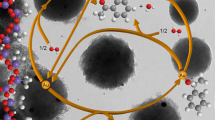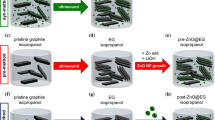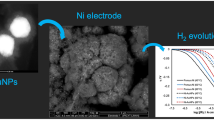Abstract
We propose here a one-pot synthetic approach to prepare sol–gel graphite electrodes containing gold nanoparticles (AuNPs). At variance with the traditional synthesis, in which AuNPs are prepared in advance with respect to the silica matrix, they were here obtained directly inside the sol–gel, during its formation. Two reduction methods, namely chemical and thermal reduction, were used to achieve AuNPs starting from a suitable gold precursor, either consisting of NaAuCl4 or HAuCl4. Different experimental parameters were tested in order to direct the synthesis of the material to the characteristics sought, namely Si/Au molar ratio, graphite (g): silane precursor (mL) ratio, chemical nature of the gold precursor and of the reductant, duration and temperature of thermal treatment. Sol–gel was prepared by means of sonocatalysis, in order to reduce the amount of solvent and time necessary for the hydrolysis step. Composition of the material, as well as shape, size and distribution of AuNPs inside the silica matrix was evaluated by spectroscopic and microscopic techniques. Furthermore, electrochemical tests allowed us to ascertain the good conductivity of the composite material and the electrocatalytic activity of AuNPs with respect to glucose and ascorbic acid oxidation. These tests demonstrated that the electrodes obtained by thermal reduction show the best performance in terms of sensitivity for the detection of these analytes, suggesting the possible application of this composite in the field of amperometric sensing.







Similar content being viewed by others
Explore related subjects
Discover the latest articles, news and stories from top researchers in related subjects.References
Tsionsky M, Gun M, Glezer M, Lev O (1994) Sol-gel-derived ceramic-carbon composite electrodes: introduction and scope of applications. Anal Chem 66:1747–1753
Lev O, Tsionsky M, Rabinovich L, Glezer V, Sampath S, Pankratov I, Gun J (1995) Organically modified sol-gel sensors. Anal Chem 67:22A–30A
Collinson MM, Howells AR (2000) Sol–gels and electrochemistry: research at the intersection. Anal Chem 72:702A–709A
Rabinovich L, Lev O (2001) Sol–gel derived composite ceramic carbon electrodes. Electroanal Int J Devoted Fundam Pract Asp Electroanal 13:265–275
Walcarius A, Mandler D, Cox JA, Collinson M, Lev O (2005) Exiting new directions in the intersection of functionalized sol–gel materials with electrochemistry. J Mater Chem 15:3663–3689
Walcarius A (2001) Electroanalysis with pure, chemically modified, and sol–gel-derived silica-based materials. Electroanal Int J Devoted Fundam Pract Asp Electroanal 13:701–718
Walcarius A (2018) Silica-based electrochemical sensors and biosensors: recent trends. Curr Opin Electrochem 10:88–97
Seeber R, Terzi F, Zanardi C (2014) Functional materials in amperometric sensing: polymeric, inorganic, and nanocomposite materials for modified electrodes. Springer, Heidelberg
Juan-Díaz MJ, Martínez-Ibánez M, Hernández-Escolano M, Cabedo L, Izquierdo R, Suay J, Gurruchaga J, Goni I (2014) Study of the degradation of hybrid sol–gel coatings in aqueous medium. Prog Org Coat 77:1799–1806
Brinker CJ, Scherer GW (1990) Sol gel science: the physic and chemistry of sol–gel processing. Academic Press Inc., New York
Cordero-Rando MM, Hidalgo-Hidalgo de Cisneros JL, Blanco E, Narajo-Rodriguez I (2002) The sonogel-carbon electrode as a sol–gel graphite-based electrode. Anal Chem 74:2423–2427
Ballarin B, Zanardi C, Schenetti L, Seeber R, Hidalgo-Hidalgo de Cisneros JL (2003) Synthesis and electrochemical characterisation of novel sonogel-carbon-polythiophene microstructured electrodes. Synth Metals 139:29–33
Abdelrahim MYM, Benjamin SR, Cubillana-Aguilera LM et al (2013) Study of electrocatalytic activity of cerium oxide and gold-studded cerium oxide nanoparticles using a sono-gel-carbon material as supporting electrode: electroanalytical study in apple juice for babies. Sensors 13:4979–5007
Crespo-Rosa JR, Zanardi C, ElKaouitit M, Terzi F, Seeber R, Naranjo-Rodriguez I (2014) Electroanalytical applications of a graphite-Au nanoparticles composite included in a sonogel matrix. Electrochim Acta 122:310–315
Daniel M-C, Astruc D (2014) Gold nanoparticles: assembly, supramolecular chemistry, quantum-size-related properties, and applications toward biology, catalysis, and nanotechnology. Chem Rev 104:293–346
Wang J, Pamidi PVA (1997) Sol–gel-derived gold composite electrodes. Anal Chem 69:4490–4494
Jena BR, Raj CR (2006) Enzyme-free amperometric sensing of glucose by using gold nanoparticles. Chem Eur J 12:2702–2708
Maduraiveeran G, Ramaraj R (1951) Gold nanoparticles embedded in silica sol-gel matrix as amperometric sensor for hydrogen peroxide. J Electroanal Chem 608:52–58
Turkevich J, Stevenson PC, Hillier J (1951) A study of the nucleation and growth processes in the synthesis of colloidal gold. Discuss Faraday Soc 11:55–75
McFarland AD, Haynes CL, Mirkin CA, Van Duyne RP, Godwin HA (2004) Color my nanoworld. J Chem Educ 81:544A–544B
Lusvardi G, Malavasi G, Menabue L, Aina V, Bertinetti L, Cerrato G, Morterra C (2010) Bioactive glasses containing Au nanoparticles. Effect of calcination temperature on structure, morphology, and surface properties. Langmuir 26:10303–10314
Larew LA, Johnson DC (1989) Concentration dependence of the mechanism of glucose oxidation at gold electrodes in alkaline media. J Electroanal Chem 262:167–182
Burke LD, Ryan TG (1992) The role of incipient hydrous oxides in the oxidation of glucose and some of its derivatives in aqueous media. Electrochim Acta 37:1363–1370
Bello A, Giannetto M, Mori G, Seeber R, Terzi F, Zanardi C (2007) Optimization of the DPV potential waveform for determination of ascorbic acid on PEDOT-modified electrodes. Sens Act B 121:430–435
Zhao J, Griederich B (2015) Synthesis of gold nanoparticles via chemical reduction methods. In: 7th Nanocon, Brno, Czech Republic, EU
Rasband W, ImageJ Version 1.32J, National Institute of Mental Health, Bethesda, Maryland, USA
Gwyddion Version 2.53. http://gwyddion.net/. Accessed 2 Apr 2019
Angerstein-Kozlowska H, Conway BE, Hamelin A, Stoicoviciu L (1987) Filamentary steps of electrochemical oxidation of single crystal planes of Au. Part II: a chemical and structural basis of oxidation of the (111) plane. J Electroanal Chem 228:429–453
PCPFWIN 2.3. JCPDS International center for diffraction data, 637 Swarthmore 2002
Toghill KE, Compton RG (2010) Electrochemical non-enzymatic glucose sensors: a perspective and an evaluation. Int J Electrochem Sci 5:1246–1301
Rueda M, Aldaz A, Sanchez-Burws F (1978) Oxidation of L-ascorbic acid on a gold electrode. Electrochim Acta 23:419–424
Hu IF, Kuwana T (1986) Oxidative mechanism of ascorbic acid at glassy carbon electrodes. Anal Chem 58:3235–3239
Manzanares MI, Solfs V, de Rossi RH (1986) Effect of cyclodextrins on the electrochemical behaviour of ascorbic acid on gold electrodes. J Electroanal Chem 407:141–147
Zanardi C, Terzi F, Seeber R (2010) Composite electrode coatings in amperometric sensors. Effects of differently encapsulated gold nanoparticles in poly(3,4-ethylendioxythiophene) system. Sens Actuators B 148:277–282
Acknowledgements
This research was financed with funds from the University of Modena e Reggio Emilia, (Project FAR 2015, “Sviluppo Di Materiali A Base Silicatica Per Applicazioni Sensoristiche” Decreto rettorale n. 267/2016 Prot. n. 81676 del 28/06/2016). Authors also thank the “Centro Interdipartimentale Grandi Strumenti” (CIGS) of the University of Modena e Reggio Emilia for instrument availability and assistance.
Author information
Authors and Affiliations
Corresponding authors
Additional information
Publisher's Note
Springer Nature remains neutral with regard to jurisdictional claims in published maps and institutional affiliations.
Electronic supplementary material
Below is the link to the electronic supplementary material.
Rights and permissions
About this article
Cite this article
Ligabue, M.L., Terzi, F., Zanardi, C. et al. One-pot sonocatalyzed synthesis of sol–gel graphite electrodes containing gold nanoparticles for application in amperometric sensing. J Mater Sci 54, 9553–9564 (2019). https://doi.org/10.1007/s10853-019-03580-y
Received:
Accepted:
Published:
Issue Date:
DOI: https://doi.org/10.1007/s10853-019-03580-y




